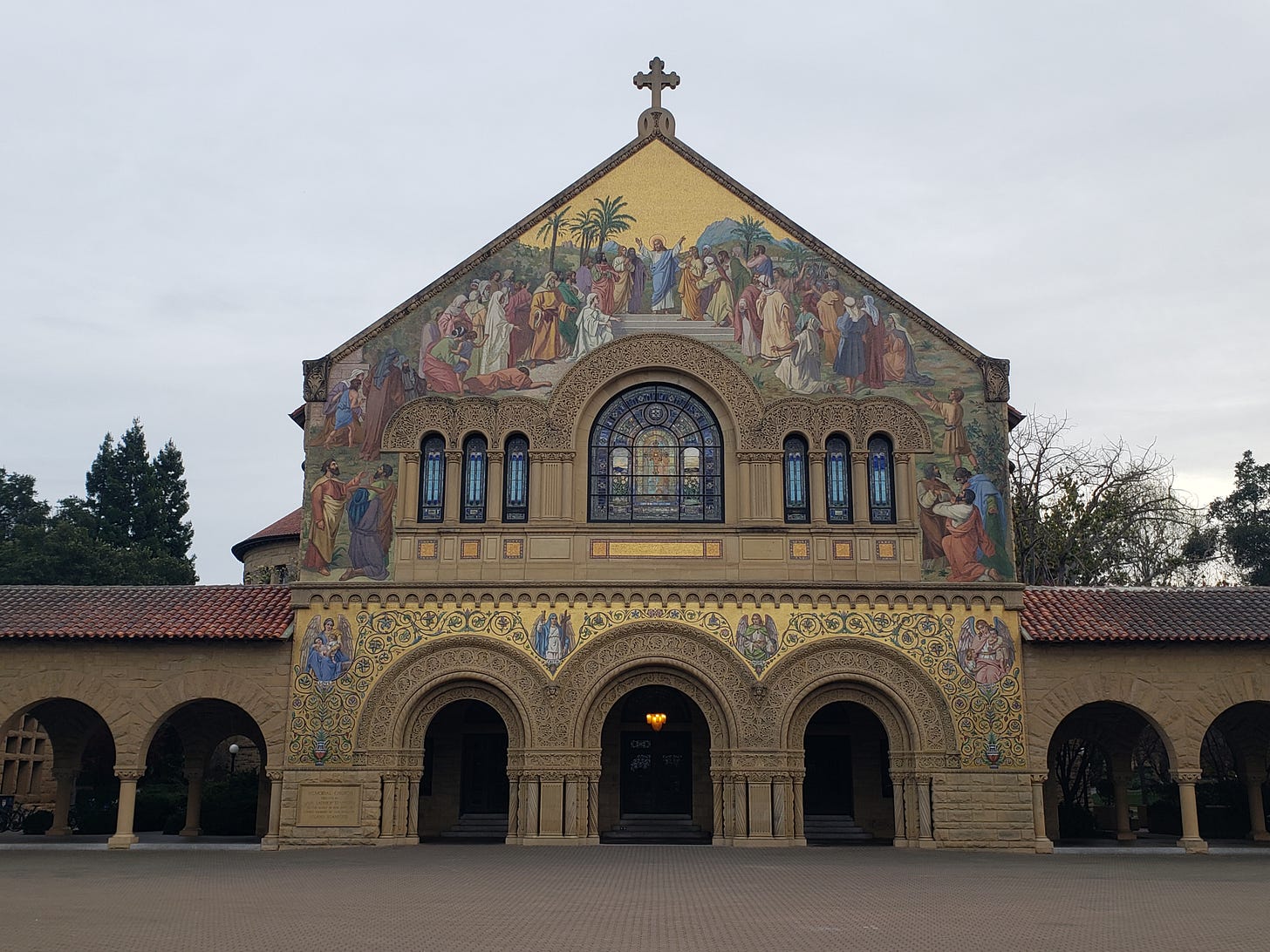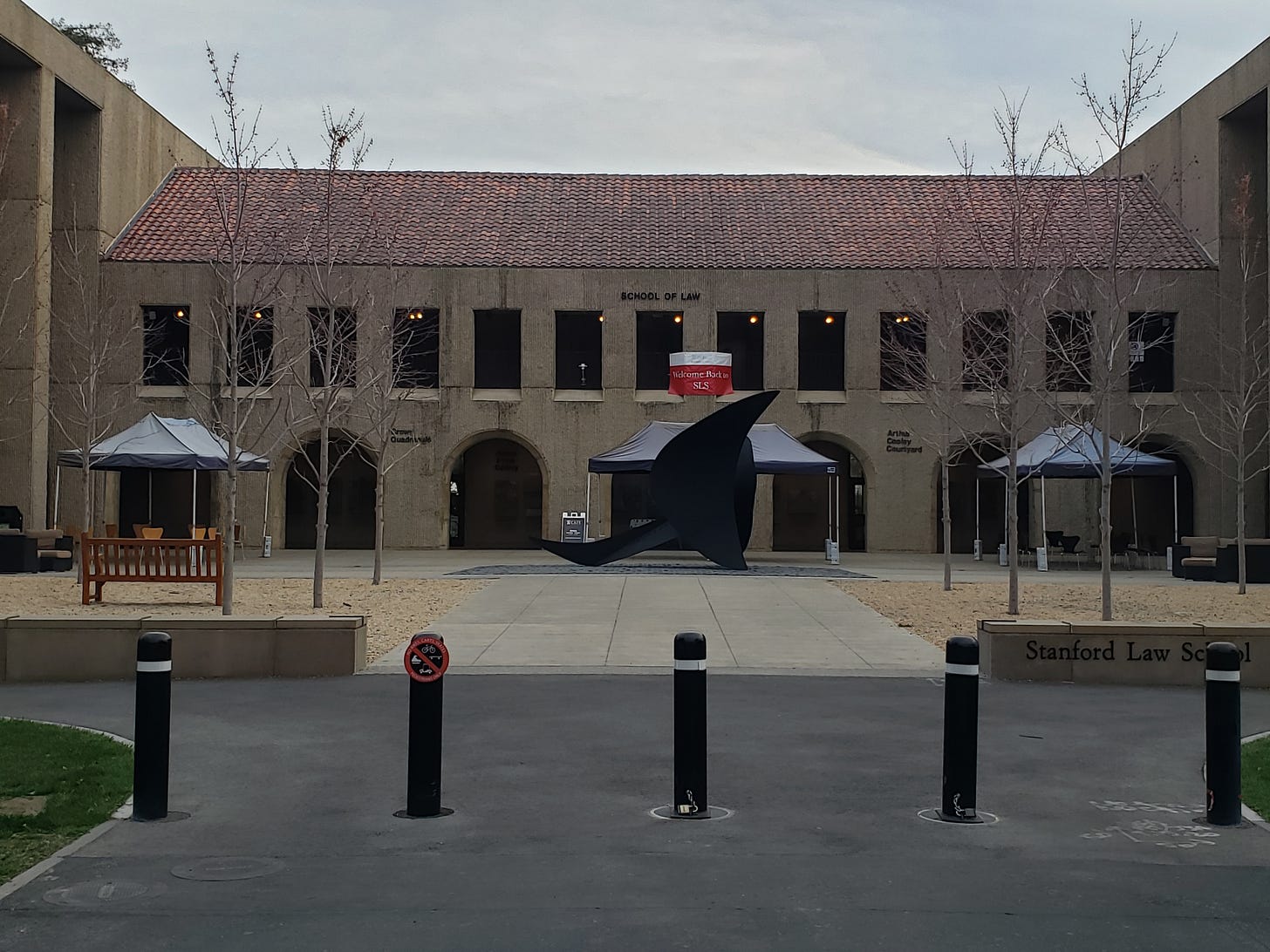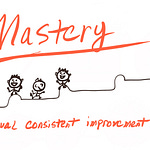It’s Friday, and I just boarded the train from Palo Alto station back to SF for the night. My phone has been dead for a few hours now, and the steps that I’ve taken since going for my “short walk” after work are currently clocking in at 28,541, meaning that my short walk turned into a 10 miler or so. With backpack.
A small price to pay for adventure.
What was I doing?
By the end of my journey, my answer is that I made a pilgrimage to this sacred place.
This is the Memorial Church, and it can be found on the Stanford University campus.
I had never been to Stanford, and after work, I decided to go check it out for myself.
I had driven through it once before, but as it turns out, that paled in comparison to taking a few hours to walk the place and soak up the architecture, rich heritage, attention to detail, and one-and-only Stanford vibe.
A few items that struck me while walking through:
It’s the only campus I’ve ever been to that I’ve noticed nearly all the names on the science and engineering buildings. A rare feat, indeed. Gates, Allen, Moore, Hewlett, Packard. Not exactly renaissance figures.
The campus is literally located off of Sand Hill Road! This single road running through Palo Alto, Menlo Park, and Woodside is the most iconic name in venture capital. Period.
Stanford is a school well-known for teaching skills for our modern world. It’s a school where you not only research new things, but you take those new things and build businesses out of them that change the world.
Yes, there was tech everywhere. From engineering to computer science to product design to the impressive Stanford Medical Center facilities.
And yes, Stanford Business School, Stanford Law, Hoover Tower, and the Memorial Court gave off their distinctive vibes.
But it was more than that.
The architecture and sheer scale of the campus dwarfed my imagination; it forced me to confront the magnitude that it represents. The beauty and distinctive character of the campus drew me in; it challenged me to revel in the achievement that is this place.
Now, it wasn’t all rainbows and unicorns; there were certainly some signs of the stereotypes that most people have about the majority of folks who go to schools like Stanford.
“No orderves!?” a student quips into her phone as she cruises by me on a bicycle.
“How old is Tim Cook?” a student rollerblading with her dog asks, to which her companion dog walker replies “I don’t know but he’s not like an O’G’."
To be honest, Stanford is also a place where I’d recommend putting your best game face on. Nearly everyone outside of visiting families that you pass by has a look on their face that demonstrates in not-so-subtle ways that they mean business. They’re here to compete and win.
But alas, despite the areas that in my more cynical moments I might have regarded as negative or distasteful in some manner, I focused on what mattered to me. I focused on the feeling that it gave me to be on this hallowed ground. I focused on the positive; on maximizing the value that simply being there and being grateful for having the opportunity and time to explore and adventure, created for me.
Everything else – even if it kind of gave me that dumpster fire feeling; I just let it burn.
Letting Fires Burn
During my second week as FourthBrain’s Head of Product, this was the fundamental lesson that crystallized for me. You must focus on the most important things with the biggest potential upside to create value, and you have to let everything else go on burning.
As I’ve worked to identify various problems that need fixing around the company, my list has continued to grow. Turning from problem to problem and executing solution after solution is a losing strategy after the first few days. The less forethought that you give each problem and solution, the faster your days go, and the less genuine productivity and happiness you feel. Then the vicious cycle of decline repeats.
In this paradigm, as you accomplish your work, you’re left feeling lost. Work becomes a set of tasks to be done. There is no strategy here; no guiding principle.
Work like this is dead work. You can’t sustain yourself or your business on work like this.
So what is to be done?
Well, instead of simply moving from problem to problem and putting out fires, you have to group some of the small fires together and consider them as one larger fire; let’s call this a project. Then you have to group some of the larger fires together into one great big fire; let’s call this an initiative.
Once we can contextualize great big fires next to one another, and we can take a perspective that allows us to stand above the (now-micro) fires that are burning, we can elevate ourselves to a “super” vision role, where we can actually distinguish between one great big fire and another.
The great big fire that’s burning blue-hot over there is probably more important to start addressing than the great big fire that’s only glowing red-hot. But, maybe not. Maybe it matters more where the fires are located.
Let’s call these colors, locations, or other distinctions the themes of our firefight.
So we’ve got tasks, projects, initiatives, and themes. We’re building our product roadmap from the bottom up!
We’re moving from front-line firefighters to fire-chief status. Of course, the chief is always willing and able to jump into a particularly important or intense firefight.
So which fires we should work on putting out?
Well, it depends on what we’re aiming at, and how we plan to get there. We simply can’t be everywhere all at once putting out every fire. We have to let some fires burn.
How do we choose?
We choose based on our current business focus. This primary business objective is the “O” in OKRs, the classic Objectives and Key Results framework used by companies like Google, Adobe, and Netflix. The Key Results are the Key Performance Indicators or KPIs, that tell us if we’re moving towards or away from the objective.
A set of OKRs is a system, with the “O” at the top providing the aim. Of course, there are other systems that one can use for product strategy, but the fundamental insight is that there has to be a guiding principle at the top.
As W. Edwards Deming said, “without an aim, there is no system.”
You might say that without an aim, fire fighting reigns.
In other words, without an aim, you’re aimless!
Crucially, to aim means to exclude everything else that you're not aiming at. This is true even if you’re ignoring great big dumpster fires.
For example, right I’m excluding everything else that I could be aiming at to write this blog.
Ahh, life is but an exercise in ignore-ance and figuring out what not to do.
My 90 Day Plan, a Personal Roadmap for Getting to No
I haven’t yet completed a coherent high-level product strategy and roadmap.
As you can probably tell, I need to leverage OKRs to build the roadmap, which will consist of - in agile software dev parlance - themes, initiatives, projects (a.k.a. epics), and tasks (a.k.a. stories). Atop OKRs sit a few other things, but those are topics for another week.
However, I’m starting to zero in on all of this. I have created a 30/60/90 day plan and worked closely with our small team of generalists and our CEO to iterate on it.
For example, this week I realized that there were a lot of things that I should NOT be doing.
So I didn’t. Or if I was spending time on them, I stopped.
This was true for many of those things that, weeks out from starting the job, I thought that I might have time to do. I had to deploy radical candor for these crucial conversations to align aims with everyone.
My approach went something like this:
“I will not be spending time on A, B, or C, in the next X days, but I would like to work with you on areas D or E with Y% of my time in an effort to create the largest outsized, measurable impact on our Z business objective.”
Herein lies the power of crafting your first 30/60/90-day plan. It is your personal roadmap. Writing it forces you to think through what you should be doing and why.
Take product marketing as an example; spending 0% of my time on it would be unacceptable. On the other end, spending 50-100% of my time on would be equally unreasonable. Instead, more like 20% of my time seems to be about right, at least for the first 30 days.
This wasn’t obvious to me on day 1, but it is heading into day 11.
You see there are many things that I could do to try and make an impact on conversion percentages in different parts of our funnel.
Should I be helping to create content? Should I be giving talks at events? I love doing both of these things, but so what? That’s not the point. That’s the wrong level of analysis. That’s looking at small fires and being drawn like a moth to a random flame. There’s no strategy there.
When you’re focused on building online cohort-based course products, you want people to become subscribers, then leads, then applicants, enrollees, graduates, alumni, and community members. Here they’ll do things like offer peer support, mentorship, or guest speaking. Community members also attend and host events, evangelize your product and brand through word of mouth and other channels, are some of the best future instructors, ultimately could hire future grads, support future capstone projects, and are more or less the lifeblood of your products.
Our core flywheel depends on much of this, while our current distribution strategy depends on conversions early in the funnel.
And I’m concerned with my first 30 days, and 20% of my time is 1 day per week. We’re talking about four working days. How can I make an impact?
A few questions I’ve been considering: Where is the conversion rate bottleneck for each product (course)? What does the data tell us? Whare are our hypotheses about why? What does this mean for how I should spend my four days? What specific piece of technical content is the highest leverage thing for me to revamp? How will we measure if it’s moving the needle towards more bottom-line revenue (i.e., paid enrollees) in the upcoming cohorts?
I’m pretty sure that I know what I need to do next with that 20% of my time. I’m on the path with that.
What about everything else marketing-related?
First-60 Greg has to let it burn.
Let it burn; get to no. Do this with all of your work in the first 30, 60, and 90 days, and you’ll do it for all the days thereafter.
A solid product strategy and roadmap appear to be in your short-term future.
With some disciplined consistency, some longer-term success may just come along too, somewhere between ed and tech.


















Share this post